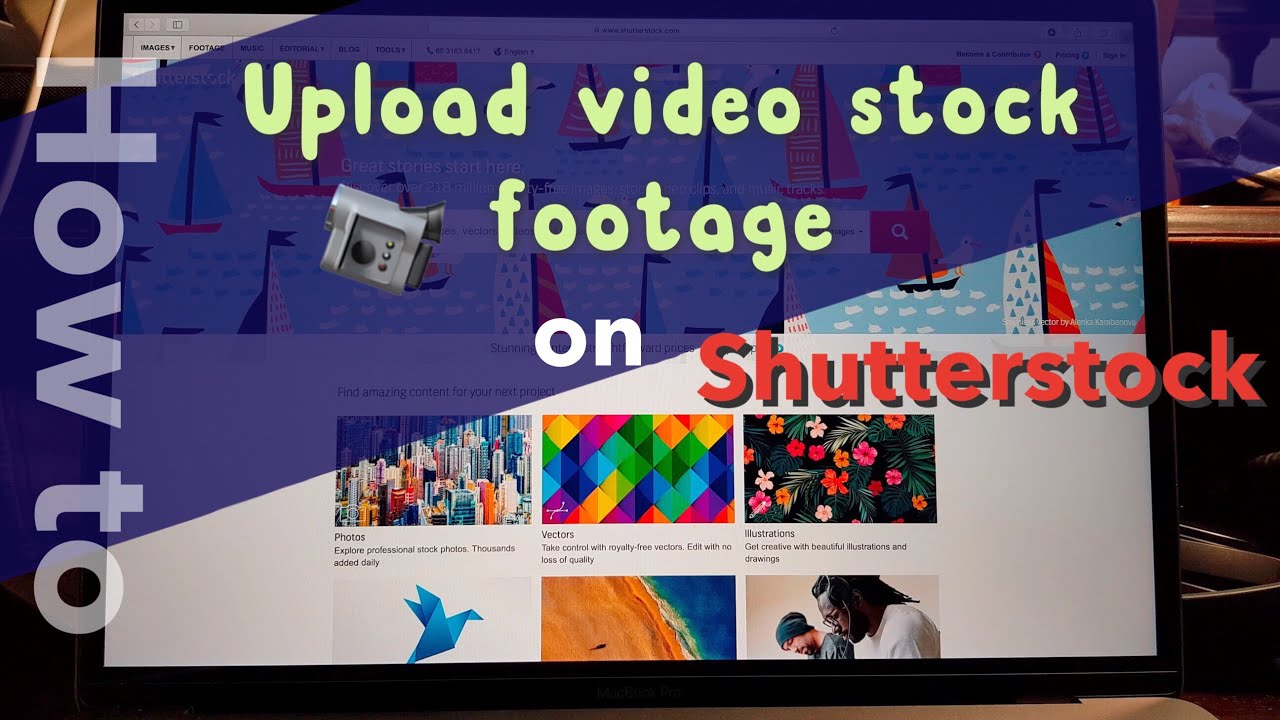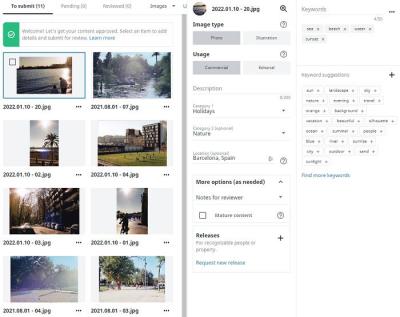Thinking about sharing your amazing footage with a global audience? Shutterstock offers a fantastic platform called Editorial, where creators like you can upload videos related to news, current events, and trending topics. Whether you’re capturing a bustling city street, a lively protest, or a significant cultural event, Shutterstock Editorial is the place to showcase your work. But before diving in, it’s important to understand the process and guidelines to ensure your videos are accepted and reach the right viewers. Let’s walk through the essentials so you can confidently submit your editorial videos and get your content seen worldwide!
Understanding Shutterstock Editorial Content Guidelines
Before you hit the upload button, it’s crucial to familiarize yourself with Shutterstock’s Editorial Content Guidelines. These rules help maintain the quality and legality of the content on the platform and protect both creators and viewers. Here’s what you need to keep in mind:
- Newsworthiness and Timeliness: Your videos should capture current events, newsworthy moments, or trending topics. Content that’s outdated or irrelevant might not qualify.
- Legal Considerations: Always ensure you have the right to submit the footage. This means avoiding copyrighted material, trademarks, or private property without permission. If your video features recognizable individuals, you might need a model release.
- Respect Privacy and Sensitivity: Be mindful of subjects that are private or sensitive. Avoid videos that could infringe on personal privacy or cause harm or offense.
- Quality Standards: High-resolution videos (preferably 4K or HD) with clear focus, good lighting, and minimal noise tend to perform better. Avoid shaky footage or poor audio quality.
- Content Restrictions: Shutterstock prohibits certain types of content, such as violent, graphic, or illegal activities. Content must adhere to community standards and legal requirements.
To make things easier, Shutterstock provides a detailed list of what’s acceptable and what’s not. Always review these guidelines carefully before submitting. Remember, adhering to these standards not only increases your chances of acceptance but also helps your videos make a positive impact on viewers who rely on accurate, timely news footage.
Preparing Your Videos for Submission
Before you hit that submit button, it’s crucial to make sure your videos are polished, professional, and meet Shutterstock’s standards. Think of this step as your chance to put your best foot forward—after all, high-quality content gets approved faster and attracts more buyers!
Here’s a quick checklist to help you prepare your videos:
- Resolution and Quality: Ensure your videos are at least 1920×1080 pixels (Full HD). Shutterstock prefers crisp, clear footage without pixelation or compression artifacts.
- Frame Rate: Keep your frame rate consistent, ideally between 24-30 fps. Avoid sudden jumps or irregular frame rates that can make your footage look choppy.
- File Format: Submit your videos in popular formats like MP4 (H.264 codec). This format strikes a good balance between quality and file size.
- Length: Shutterstock accepts videos from 5 seconds up to 60 minutes, but shorter, engaging clips tend to perform better. Aim for around 10-30 seconds if you’re just starting out.
- Audio: Make sure your audio is clear, balanced, and free of background noise. If your video contains dialogue, ensure it’s easy to understand.
Editing Tips to Enhance Your Videos
Taking a little extra time in editing can make a big difference:
- Color Correction: Brighten dull footage and correct colors to make your video vibrant and eye-catching.
- Stability: Use stabilization tools to smooth out shaky footage, especially if you recorded handheld.
- Trimming: Cut out unnecessary parts to keep your video concise and engaging.
- Adding Text or Graphics: If relevant, overlay subtle text or graphics to enhance your message—but avoid cluttering the scene.
Final Checks
Before uploading, do a quick review:
- Watch the entire video to catch any errors or issues.
- Check the file size and resolution requirements.
- Ensure your video has a descriptive, accurate filename.
- Make sure your metadata (title, description, tags) is relevant and keyword-rich.
Preparing your videos thoughtfully not only increases your chances of acceptance but also sets you up for success in the Shutterstock marketplace. Remember, quality over quantity wins the day!
Create a Shutterstock Contributor Account
Ready to get your videos out into the world? The first step is creating a contributor account on Shutterstock. Don’t worry, it’s straightforward, and I’ll walk you through it step-by-step.
Step-by-Step to Sign Up
- Visit the Shutterstock Contributor Page: Go to https://submit.shutterstock.com
- Click on “Join Now”: You’ll find this button prominently displayed on the page.
- Fill Out the Registration Form: Enter your personal details, including your name, email address, and create a strong password. You might also be asked to choose your country of residence.
- Agree to Terms & Conditions: Read through the contributor agreement carefully, then check the box to accept.
- Verify Your Email: Shutterstock will send you a verification email. Click the link in that email to activate your account.
Setting Up Your Profile
Once your account is active, it’s worth spending a few minutes setting up your profile:
- Upload a Profile Picture: A friendly photo helps build trust with buyers.
- Add Payment Details: Enter your preferred payout method—PayPal, bank transfer, etc.—so you can get paid easily.
- Complete Your Tax Information: Depending on your country, you might need to fill out tax forms for compliance.
Understanding Shutterstock’s Submission Workflow
After creating your account, you’ll have access to the contributor dashboard. Here, you can:
- Upload Videos: Use the upload button to select your prepared files.
- Add Metadata: Provide titles, descriptions, and tags—this is key to making your videos discoverable.
- Review and Submit: Check everything over one last time, then hit “Submit” for review.
And that’s it! Creating your contributor account is the gateway to sharing your creative work with a global audience. Once you’re set up, the real fun begins—uploading, optimizing, and earning from your videos. Happy contributing!
Uploading Your Editorial Videos to Shutterstock
Alright, you’ve got your editorial videos ready and polished—great job so far! Now comes the exciting part: uploading them to Shutterstock. This step is pretty straightforward, but it’s important to follow the process carefully to make sure your videos get approved and are available for licensing.
First, log into your Shutterstock Contributor account. If you haven’t signed up yet, you’ll want to do that first—it’s free and quick. Once you’re logged in, navigate to the Upload section, usually found in the dashboard menu.
Here’s a quick rundown of the uploading process:
- Select Your Files: Click the upload button and choose the video files from your device. Make sure your videos meet Shutterstock’s technical specifications for editorial content (more on this in the metadata section).
- Check Video Format: Shutterstock accepts formats like MOV and MP4. Ensure your videos are encoded properly—using H.264 codec is a safe bet.
- Upload in Batches: If you have multiple videos, you can upload them all at once. Keep an eye on the progress bar to make sure everything uploads smoothly.
- Processing Time: After uploading, your videos will undergo processing. This includes a quick check to ensure they meet Shutterstock’s guidelines, which can take anywhere from a few minutes to a few hours.
During the upload, avoid navigating away from the page or closing your browser window—that can interrupt the process. Once the videos are uploaded and processed, you’ll see them listed in your contributor dashboard, ready for the next step: adding metadata.
Pro tip: Before you hit submit, double-check your video files for any issues—like corrupted files or mismatched formats—to prevent delays in approval. Also, make sure your internet connection is stable to avoid interruptions during upload.
Adding Metadata and Tags to Your Videos
This step is crucial! Proper metadata and tagging help your editorial videos get discovered by the right audiences and increase your chances of earning licensing fees. Think of metadata as the description and keywords that tell Shutterstock what your video is about.
Once your videos are uploaded and processed, you’ll be prompted—or you can manually go to each video in your dashboard—to add details. Here’s what you should focus on:
Title
Write a clear, descriptive title that captures the essence of your video. Be specific but concise. For example, instead of “News Footage,” try “Protest Rally in Downtown City Square, September 2023.”
Description
This is your chance to tell the story behind the footage. Include relevant information such as location, date, and key subjects. Keep it natural and informative, as it helps potential buyers understand the context.
Keywords and Tags
Keywords are the most important part of metadata for discoverability. Use relevant tags that describe the content, themes, and subjects of your video. Think about what someone might search for to find your footage.
Here are some tips for effective tagging:
- Be specific: Use detailed keywords like “city protest,” “crowd gathering,” “news footage,” instead of generic terms.
- Include related terms: Think about synonyms or related topics—like “demonstration,” “rally,” or “public event.”
- Use location tags: Mention the city, neighborhood, or landmark if applicable.
- Stay relevant: Only add tags that truly describe your footage—irrelevant tags can hurt your credibility and search rankings.
Additional Metadata
Depending on the platform, you might also be able to add copyright info, model releases (if applicable), and other details. For editorial videos, accuracy is key—make sure all information is truthful and precise.
Remember, well-crafted metadata makes your videos more visible to buyers searching for specific content. Take your time to fill out each field thoughtfully—this investment pays off in the form of more views and licensing opportunities.
And that’s it! Once you’ve uploaded your videos and added detailed, accurate metadata, you’re just a few steps away from making your editorial footage available for licensing. Keep an eye on your dashboard for approval updates, and good luck with your Shutterstock journey!
Reviewing and Submitting Your Videos for Approval
Once you’ve uploaded your videos to Shutterstock’s contributor portal, the next step is to review and submit them for approval. Think of this stage as your final quality check before your videos go live — it’s all about making sure everything looks polished and meets Shutterstock’s standards.
First, take a deep breath and give your videos a good look. Check for any issues like poor lighting, shaky footage, or audio problems. Even small imperfections can sometimes cause a video to be rejected, so it’s worth being thorough. Use the platform’s preview feature to see how your videos will appear to reviewers, and pay attention to things like color consistency and audio clarity.
Next, fill out all the necessary metadata — titles, descriptions, keywords, and categories. Clear, relevant, and keyword-rich metadata not only helps your video get discovered but also shows reviewers that you’ve put effort into making your content easy to find and understand. Be honest and accurate in your descriptions; misleading information can lead to rejection.
Once everything looks good, hit the “Submit for Review” button. Shutterstock reviewers will then evaluate your video based on their technical, content, and quality standards. This process can take anywhere from a few days to a couple of weeks, depending on the volume of submissions. During this time, avoid making changes to the video or metadata unless instructed to do so by Shutterstock.
If your video is approved, congratulations! It will be added to Shutterstock’s library and available for licensing. If rejected, don’t be discouraged — Shutterstock usually provides feedback on why your video didn’t pass. Use this constructive criticism to improve your future submissions. Remember, many successful contributors faced rejections before finding their groove, so keep refining your work!
Tips for Increasing Approval Chances
Getting your videos approved the first time can sometimes feel like a challenge, but with a few smart strategies, you can boost your approval rate significantly. Here are some practical tips to help you make the most of your submissions:
- Follow Shutterstock’s guidelines closely: Carefully read their technical requirements, content policies, and style tips. This helps ensure your videos meet all the baseline standards.
- Focus on high-quality footage: Use a good camera and tripod to keep your shots steady. Make sure your videos are well-lit, properly exposed, and free of distracting elements.
- Pay attention to audio: Clear, crisp audio is essential. Use external microphones if possible, and eliminate background noise during editing.
- Keep content relevant and original: Avoid copyrighted material or overly generic footage. Unique content that fills a niche or showcases fresh perspectives is more likely to succeed.
- Use descriptive and accurate metadata: Craft compelling titles and descriptions filled with relevant keywords. Good metadata helps reviewers understand your content and improves discoverability.
- Preview your videos before submission: Watch your videos multiple times to catch any issues. Ask a friend or colleague for a second opinion to identify potential flaws you might have missed.
- Stay updated with Shutterstock’s trends: Browse current popular categories and styles on the platform. Aligning your content with trending topics can increase your chances of approval and sales.
- Be consistent and patient: Regularly submit quality content, and don’t get discouraged by rejections. Building a portfolio takes time, and persistence pays off.
By applying these tips, you’ll not only improve your chances of approval but also enhance the overall quality of your portfolio. Remember, every successful contributor started somewhere, and continuous improvement is key to thriving on Shutterstock. Keep creating, keep learning, and your videos will find their audience!
Conclusion and Additional Resources
Submitting your editorial videos to Shutterstock can be a rewarding way to share your creative work and generate income. Throughout this guide, we’ve covered essential steps such as understanding Shutterstock’s requirements, preparing your videos, and navigating the submission process. Remember, attention to detail—like ensuring your videos are high quality, properly labeled, and meet the platform’s guidelines—can significantly improve your chances of acceptance. Keep practicing, refining your editing skills, and stay updated with Shutterstock’s policies to maximize your success.
For further assistance and to deepen your understanding, consider exploring the following resources:
- Shutterstock Contributor Help Center: Comprehensive guides and FAQs for new contributors.
- Video Editing Tutorials: Platforms like YouTube and Skillshare offer tutorials to enhance your editing techniques.
- Community Forums: Engage with other contributors to share tips, ask questions, and get feedback.
- Copyright and Licensing Information: Understand the legal aspects of submitting editorial content to avoid issues.
By leveraging these resources and continually improving your craft, you’ll be well-positioned to succeed in submitting compelling editorial videos to Shutterstock. Happy filming and best of luck with your submissions!



